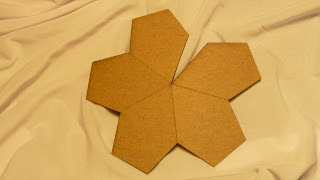For our first project we have 3 weeks to design something based on the following criterion:
1. Expose
2. Shapes cover curved surfaces (i.e. turtle shells)
3. Smart surface
We didn't have too much trouble brainstorming ideas that met 2/3 of the prompts; however, meeting all three was a challenge. One of the biggest issues we dealt with was determining whether our ideas could actually be considered a smart surface.
Based on criteria 2 we started experimenting with polyhedra and other basic geometries that are found in nature at several different scales. For example:
The HIV virus uses the basic icosahedron for its structural efficiencies.
We also started to play with folding polygons to generate functionality:

As far as team cooperation goes for the first few meetings we all just brainstormed and explored the different ways each of us think. As the project develops I suspect we will move to a more specialized system to take advantage of our individual strengths.
-Alex









